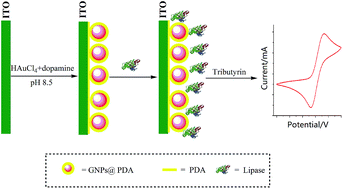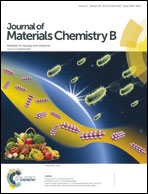An electrochemical sensor for detecting triglyceride based on biomimetic polydopamine and gold nanocomposite†
Abstract
We developed a novel electrochemical sensing strategy for tributyrin detection based on a polydopamine and gold nanoparticle hybrid (GNPs@PDA) to significantly improve the performance of the sensor. The adhesive hybrid has been easily synthesized in situ via oxidative polymerization of dopamine in the presence of HAuCl4 and the lipase was then conjugated with the GNPs@PDA easily, remaining enzymatically active and catalyzing hydrolysis of tributyrin. The biomimetic material PDA here performs well both as an ideal binding agent for attaching to the sensor surface and as a good platform for grafting of the enzyme lipase. A linear response ranging from 50 to 300 mg dL−1 and a detection limit of tributyrin as low as 0.84 mg dL−1 with a fast response time (20 s) is achieved on the GNPs@PDA platform. The value of the apparent Michaelis–Menten constant (Kappm) was obtained as 7.94 mg dL−1, which indicated high affinity of lipase to tributyrin. Furthermore, the sensor has strong anti-interference ability as well as a long shelf-life. We also use this sensor to detect triglyceride concentration in human serum samples.


 Please wait while we load your content...
Please wait while we load your content...